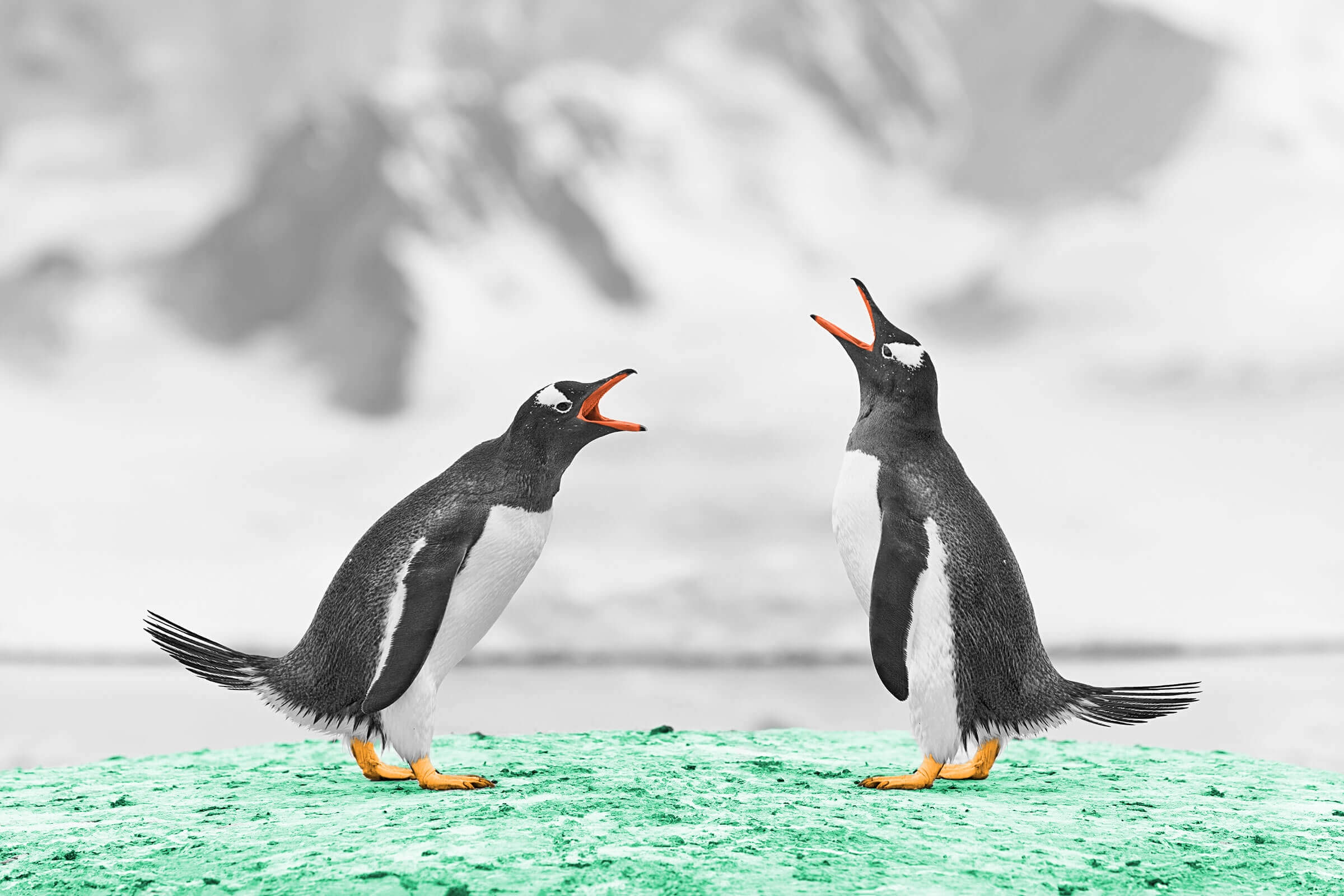

Animals are not normally known for exercising restraint when it comes to reproduction. But for all the attention paid to the promiscuity of busy breeders like dogs and jackrabbits, some critters display a different side of animal nature by mostly sticking with one partner. Scientists call these animals “socially monogamous” — a male “pair bonds” with a female to mate, raise young, and spend time together for the duration of their lives. (Occasionally, one may “cheat” with another mate but quickly return to their partner.) Here are 11 such creatures who know a thing or two about long-term relationships.
Gray Wolves
Monogamy plays an important role in keeping the peace in gray wolf packs. All of the members of a pack fall into a strict social hierarchy, at the top of which is a dominant couple formed when a leading female chooses her mate; they become the only wolves in the pack that breed. This pair guides the group’s daily hunting, resting, and pup-rearing activities (the entire pack contributes to raising the dominant pair’s young) while making sure the younger and subdominant wolves, which may include aunts, uncles, and cousins, stay in line. Gray wolf monogamy may be an evolutionary advantage: A 2019 study of gray wolves in Idaho found that the longer a dominant pair stayed together, the better their offspring’s odds of survival, likely because the parents were able to share valuable knowledge with each other and their pups over time.
Eurasian Beavers
Eurasian beavers are not only eager but ready to settle down. In each beaver colony, only one adult pair breeds. The couple will mate once a year and have one to six kits in spring or early summer. In autumn, all members of the group gnaw down small trees and collect mud and brush to build their lodges (though some colonies prefer to burrow into riverbanks). The structures are usually placed in the middle of a pond, swamp, or bog and have underwater entrances leading to a dry and cozy inner chamber, where the whole family helps raise the youngest kits and spends the winter snacking on tree bark.
Atlantic Puffins
These adorable “clowns of the sea” don’t joke around when it comes to long-term relationships. Atlantic puffins gather in large colonies on rocky cliffs overlooking the sea during the breeding season. Males attract females’ attention by hunching their bodies and grunting near a chosen nest site, usually a burrow in a rock crevice or under a boulder. Once a male and female puffin pair is bonded, they’ll stay monogamous and reunite each year to mate, greeting each other by rubbing their orange and yellow bills. A pair may even return to the same colony and burrow over multiple seasons. When not actually breeding and raising chicks, these pudgy seabirds embark on transatlantic migrations from coastal Maine and eastern Canada to Iceland, Ireland, and other parts of Western Europe, and then back again.
Kirk’s Dik-diks
A tiny African antelope with a funny name, Kirk’s dik-diks live in dry shrublands from southern Somalia to Namibia. At only 12 to 16 inches tall at the shoulder, they can easily feed on and hide among the vegetation when they’re not spending time with their monogamous mates. Male dik-diks vigorously defend their territories by urinating all over the place, thereby leaving their scent to warn away interlopers. This protective urge extends to their female partners: When the female of a pair urinates, the male follows closely behind her and covers up the female’s scent with his own, so no other males might be tempted to intervene.
Albatrosses
These huge, graceful seabirds in the family Diomedeidae are paragons of partnership. Over their long life, albatrosses spend most of their time gliding over the open ocean, but will rejoin their mate once a year to breed. Many species, such as the black-footed albatross and Laysan albatross, return to the same nesting colony and even the same nest for decades. Both parents share the work of incubating their single egg and raising the chick.
The arrangement may seem like marital bliss, but recent research has shown that “divorce” may be rising among the socially monogamous birds. In a population of wandering albatrosses with fewer females than males, a 2022 study discovered that aggressive males broke up bonded pairs — a move called “forced divorce.” Another study linked climate change to increased divorce in a colony of black-browed albatrosses, suggesting that rising ocean temperatures made food scarcer and led to more breeding failures, after which the couples went their separate ways.
Bald Eagles

Although Benjamin Franklin once disparaged (possibly in jest) the bald eagle's "bad moral character," America's national bird upholds a high standard for family life by (mostly) remaining faithful. Following a kamikaze courtship ritual in which two birds lock talons and tumble end-over-end until they nearly hit the ground, the male and female settle into a period of domestic bliss marked by dad's willingness to undertake incubation and feeding duties. The "divorce" rate for these birds is less than 5%, according to scientists. And while they spend large chunks of the year alone, bald eagles mark their fidelity with a shared long-term commitment to nest building: One such home put together by an eagle couple in Florida was found to measure 9.5 feet long and 20 feet deep. It holds the record for the largest bird's nest ever documented.
Shingleback Lizards

Also known as sleepy lizards or two-headed lizards, shingleback pairs are a common sight on the back roads of southern Australia. As with bald eagles, these bulky reptiles largely prefer to remain alone, until reuniting with the same partner for the mating season. Unlike those raptors, however, shinglebacks share virtually no child-rearing duties (there aren’t any — the offspring quickly strike out on their own), so it's unclear what draws the same couples back to one another. One theory suggests that it’s simply a matter of safety with these slow-moving animals, who trust their partners to be on the lookout while they fill their bellies.
Coyotes

Unlike some of their human counterparts who enjoy "playing the field" amid the social opportunities of big-city life, urban-dwelling coyotes have demonstrated that they'll stick with one mate for the long haul. This likely has to do with the large litters birthed by females, who need help feeding and caring for the young'uns. It also explains why coyotes are known to be unusually aggressive during and after the winter breeding season; as devoted family animals, the males are simply doing their best to divert danger from the dens of their vulnerable partners and pups.
Prairie Voles

Although the lives of prairie voles can end after a few months in the unforgiving wild, these North American rodents make the most of their brief time on Earth by forming powerful connections with a mate. This attachment becomes even more pronounced in captivity, with voles showing signs of empathizing with a stressed partner or grieving after the partner’s death. Thanks to decades of research, scientists have a good idea about the hormones that fuel such strong animal bonds, and even use them as clues to help decipher the ongoing mystery of human relationships.
White’s Seahorses

Fish in general aren't wired toward mating for life, but certain species of seahorse, including the White's or Sydney seahorse (Hippocampus whitei) in Australia, are known to engage in such behavior. This can be explained by factors such as a shrinking population and poor swimming capabilities, which make finding another mate difficult, as well as the quirk of nature that thrusts the burden of seahorse pregnancy on males. While the guys are tied up in a gestation process lasting from two to four weeks, female seahorses continuously prepare another round of eggs for insertion, ensuring the propagation of the species with an invested partner.
Gentoo Penguins

The third-largest penguin species, gentoos are best known for a distinct mode of courtship in which the male presents the female with a pebble. If accepted, the pebble marks both a symbolic gesture of a lifelong relationship and a practical tool for family building, as pebble nests serve to keep eggs and hatchlings off the cold ground. As with many other would-be monogamous animals, gentoo penguins are known to occasionally stray from their long-term mates, particularly in the controlled, predator-free environs of captivity. Regardless, the penguins almost always return to the same nesting site, suggesting that maybe it’s all about the pebbles, after all.
